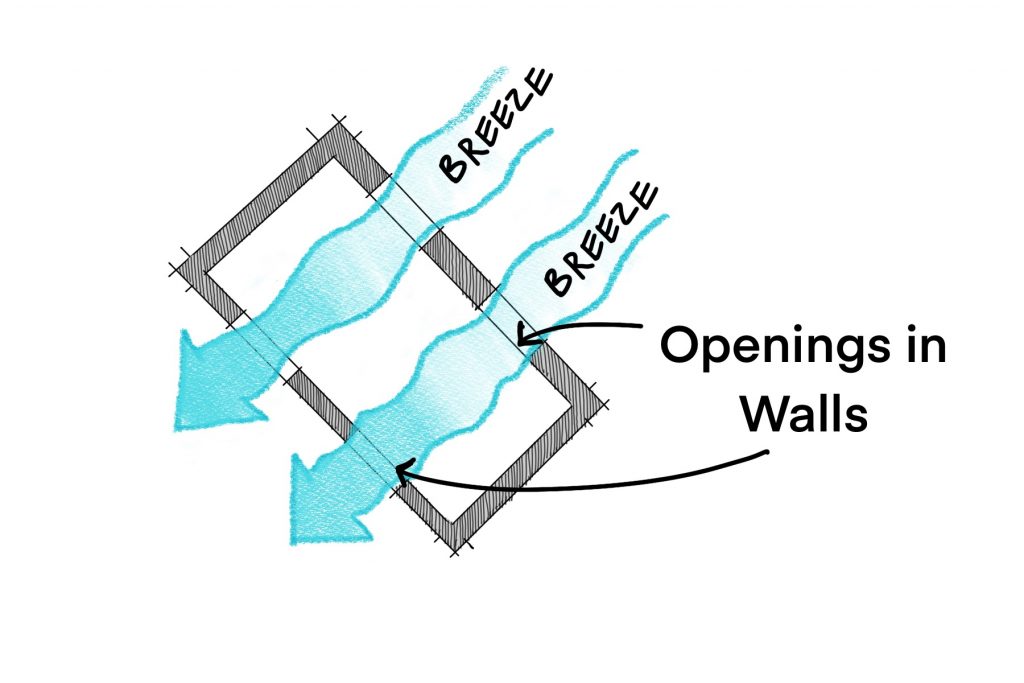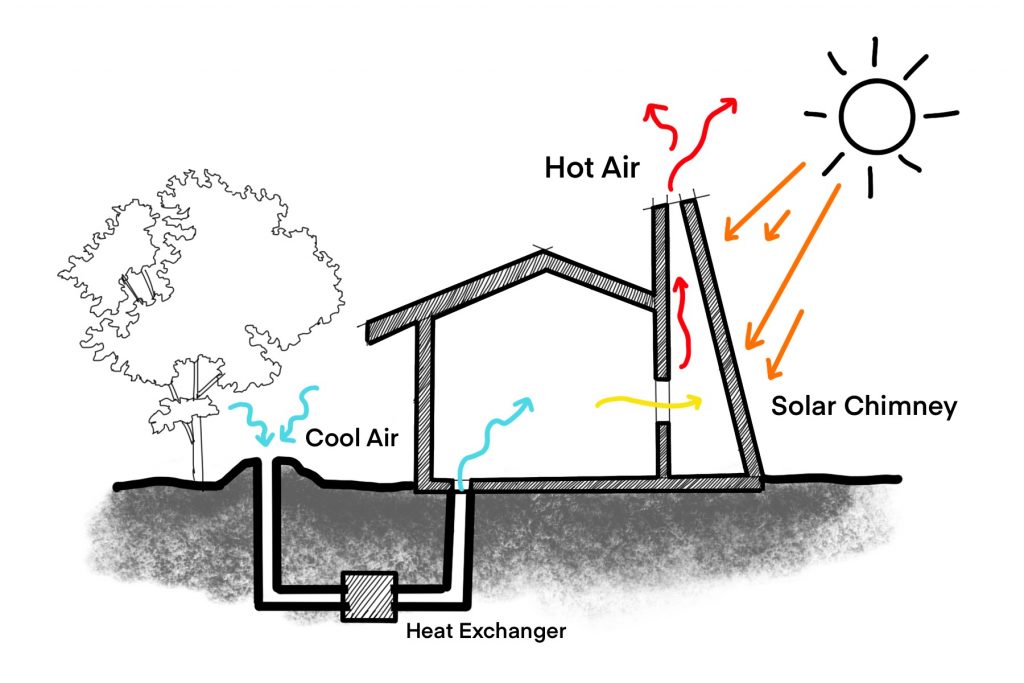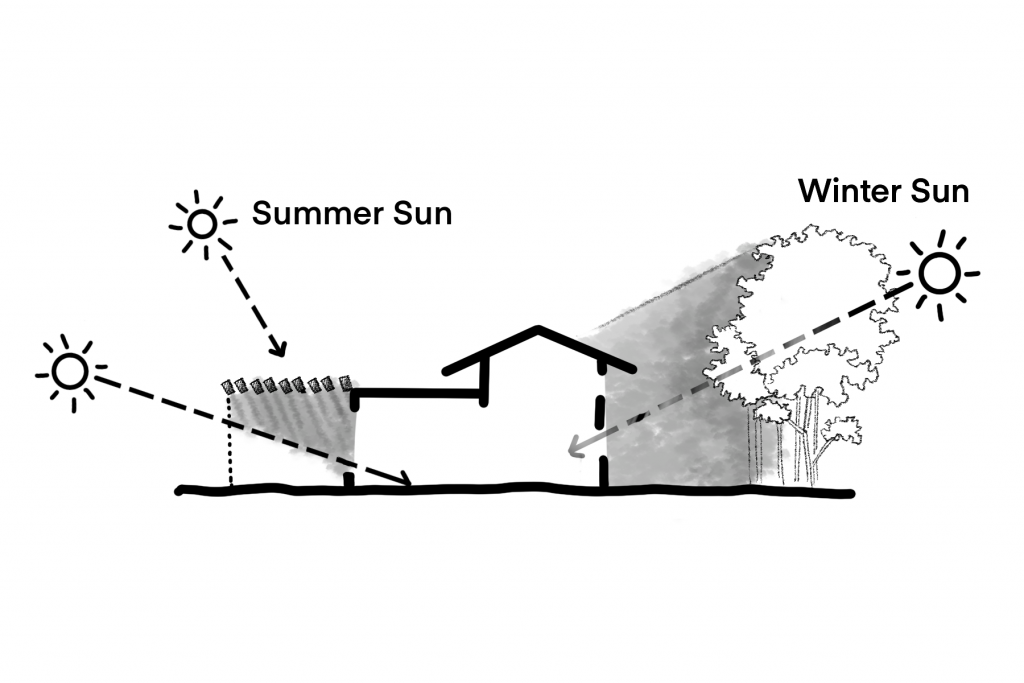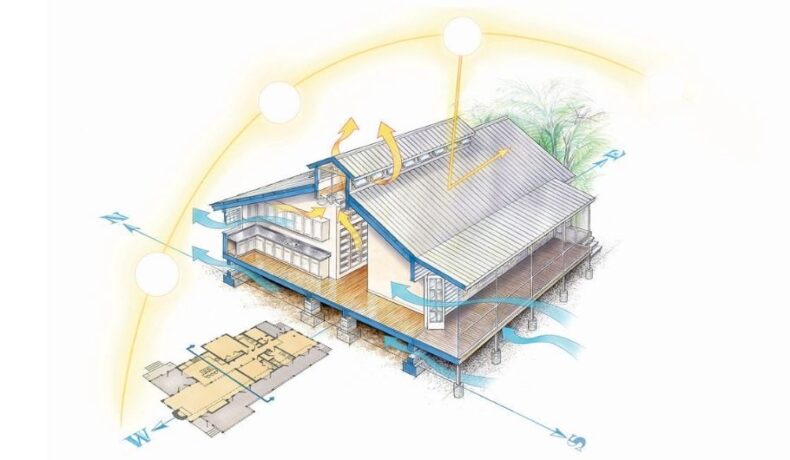With people spending more time at home than ever before, the need for comfort has become essential for productivity and relaxation.
Most homes today have central heating or cooling, depending on the region they’re in. These units consume an immense amount of electricity and energy which isn’t good for the environment or your utility bill.
If you’re looking for a more cost-effective and eco-friendly way to control the temperature of your home, this article may be exactly what you’ve been looking for.
Table of Contents
What Is Passive Cooling For Your Home?
Passive cooling is an ancient principle that is still used today in many hot and humid climates. For example, the upper-class Greeks’s built their homes with a central courtyard which often contained a body of water. This allowed for a breeze to push the hot air to the center of the complex where it would dissipate.
In ancient India, many of their public buildings had elements called Salsabil. This was essentially a steep, vertical fountain that would cool the area down through the evaporation of the water.
Today, it’s not always feasible to have a huge courtyard or fountain in the center of your home. Instead, thanks to new technologies, there are multiple other ways to cool your home passively.
So What Exactly Is Passive Cooling?
Passive cooling is when your home can regulate its temperature using different architectural elements and principles. The building regulates the temperature without you needing to take an active part in the process.
How Does Passive Cooling Work?
There are many different ways in which your home can passively cool itself. From adapting your existing air-conditioning unit to adding elements to your home.
If you’re planning on building a new home, you need to make sure that it conforms to passive cooling principles.
Passive cooling has 2 key principles:
- Reducing heat gain.
- Increasing heat loss.
Reducing Heat Gain
So how do you reduce heat gain? Well, you need to put certain elements in place that’ll help control the amount of heat entering your home.
Such elements include:
- Insulation – Helps prevent heat from entering your home in the summer while retaining heat that is already inside.
- Shading devices – These work by limiting direct sunlight from entering your home.
- Thermal mass – includes thicker walls made from brick or concrete. These absorb the sun’s heat during the day and slowly release it through the night.
Increasing Heat Loss
Increased heat loss is hugely dependent on ventilation. This can include natural cross or stack ventilation and/or mechanical ventilation. Additionally, radiative cooling is helpful in climates with cooler nights.
The building envelope, which includes the roof and walls, radiates the warm heat into the night sky, cooling down the interior of your home.
Using one of the above-mentioned methods will increase the passive heat control of your home’s environment while using 5 or more will make an immense difference. Not only is this a more eco-conscious way of cooling your home, but it’s also cost-effective
.jpg?1528130931)
Source: Manuel Herz Architects
Why Is Passive Cooling Important?
According to a study conducted in New Orleans, you can consume 50 – 55% of your household energy through your air-conditioning and heating units. Furthermore, CoolSky Systems states that the electricity generated worldwide to power these systems contributes to 7% of greenhouse gas emissions.
To ensure that we all move towards a more conscious way of living, we need to take a deeper look at conventional homes. We should look at how they work and how we can adapt them to be more sustainable.
One of the most scientifically proven ways to do this is by building or adapting your home into a passive house. And what is one of the key principles of this concept? You guessed it – passive cooling and ventilation.
With all this in mind, passive cooling becomes an important design concept to ensure that your home regulates a comfortable environment to live in whilst reducing its effect on the environment and your electricity bill.
5 Passive Cooling Methods
There are a number of passive cooling methods to choose from depending on your region and geographical location.
These include evaporative cooling through a central fountain or pond, night flushing, or ensuring your home is built around a courtyard.
However, not all these methods are feasible/applicable to all climates. Thus, we have highlighted 5 methods that can be applied to most buildings no matter your climate.
These are:
- Ventilation
- Shading
- Insulation
- Radiative Cooling
- Thermal Mass
Ventilation
Ensuring that your home has a good ventilation system will increase its ability to lose unwanted heat. There are two main types of passive ventilation – cross ventilation and stack ventilation.
Cross Ventalation
This type of ventilation occurs when a breeze enters one side of your home through an opening, cools down the air inside, and pushes the hot air through an opening on the other side. This ventilation method is dependent on the orientation of the building relative to the wind direction of your region.
Openings in the building can include windows, doors, semipermeable screens, or vents.
In cases where there is little to no wind, you can use mechanical ventilation such as ceiling fans to increase air circulation.
This method of passive cooling is the simplest. You can implement it right away by opening windows on one side of your house and a door or window on the other.

Source: Climatebiz
Stack Ventilation
Stack ventilation takes advantage of the fact that hot air rises. By allowing cool air into your home, the air heats up and rises, exiting through an opening in or above the roof.
Windcatchers, solar chimneys, whirlybird vents, and heat exchangers are a few elements that allow stack ventilation to occur.
Heat Exchanger Process
A heat exchanger is a device that allows heat to transfer from one substance to another.
In this case, warm air enters the underground heat exchanger through an external vent. The heat exchanger allows the cool temperatures of the earth to cool down the air in the vent system.
The mechanical system delivers the cold air into your home, where it will heat up and exit through an opening in the roof.
Solar Chimney Process
Another smart way to achieve stack ventilation is through a solar chimney.
A chimney is built into your home. It’s often made from a material with dense mass like concrete or brick.
The heat from the sun then warms up the chimney and the air inside, causing it to rise. As the hot air rises through the chimney, it pulls cool air into the home through openings.

Source: Climatebiz
Shading
This is an important principle that prevents heat gain inside your home.
Shading Methods:
- Planting trees and vegetation by east and west-facing facades.
- Installing louvres over windows.
- Building deeper overhangs and/or adding special window films that block heat transfer and UV rays.
Shading depends on your geographical location and the path of the sun. In the summer, the sun is at a higher angle in the sky, and in the winter, it has a lower altitude.
The exact altitude of the sun will depend on where you are located, with higher peak altitudes near the equator and lower altitudes near the poles.
The Key To Shading
The key to successful shading techniques is to block the direct sunlight from heating your home, while still letting in passive light to brighten up your living spaces.
Direct sunlight will affect the facade of your home which faces the equator, and indirect sunlight will come from the opposite direction. Correctly orientating your home during the building process is essential to using this method successfully.
The simplest method of shading is adding louvers to your home. Verticle louvers on the west and east facades will block direct morning and afternoon sun. Horizontal louvers on the north facade will block the direct sun during the summer months.

Source: Climatebiz
Insulation
Insulation acts as a buffer, controlling the amount of heat that enters your home and the amount of heat that stays in. There are many different types of insulation that you can apply in multiple layers. This will depend on how warm or cold your climate is.
Insulation has a high resistance to heat transfer, meaning that it has a high R-Value. The higher the R-Value, the harder it’ll be for the heat to move from the inside to the outside.
An important thing to remember – if you cover the majority of your walls with glass or windows, insulation in the walls won’t help much at all. That is unless you have specific windows with double or triple glazing. Combine those with built-in thermal breakers and you’ll be good to go.
Roofing As Part Of Insulation
One of the biggest areas of the building envelope that is exposed to the elements is the roof. It’s important to ensure that this part of your home is well insulated.
A good, natural way to do this is by installing a green roof. The thermal mass of the soil along with the moisture and shading from the plants forms a great insulator.
Radiative Cooling
Every material and substance has embodied energy that can be transferred.
Radiation is when this energy is transferred from one substance to another. When heat is transferred from a warmer substance to a cooler one, this is called radiative cooling.
As previously mentioned, your home’s roof is often the area most exposed to the outside air.
During the day, your roof builds up heat and at night, it radiates this heat back into the atmosphere. Since warm air rises, it would at one stage or another, interact with the ceiling. At night, the warm air would radiate its heat to the cooler roof sheeting, which would then radiate the heat to the night air.
This is a simple process that can be amplified by new technologies.
Research at Standford University uncovered a material that remained a cooler temperature than the environment around it even in direct sunlight. This research lead to the creation of a company called SkyCool. These panels radiate heat away from the building, meaning that even during the day, radiative cooling inside the home can still take place.
These panels can be linked to an existing central cooling system. They save 2 – 3x as much energy as solar panels covering the same area.
The company has also developed other products such as paint that has the same effect as the panels as well as films and treated wood.

Source: SkyCool
Thermal Mass
Almost any substance with mass can absorb heat. The more mass a substance has, the more heat it can absorb. Certain construction materials can absorb more heat than others. This creates what is known as a heat sink.
Thermal Lag
Thermal lag is a term used to describe how long it takes for a body of mass to release its heat. Brick, Concrete and Earth all have a greater thermal lag than glass for example.
Using a material with a thick thermal mass and a longer thermal lag is a great way to increase your home’s passive cooling. During the day, the walls of your home would absorb heat, keeping the inside temperature comfortable. When the temperature drops during the cooler nights, the walls would then release the heat, maintaining the temperature.
An example of homes that depend greatly on thermal mass is earth homes. They take advantage of the cooler temperature of the earth to regulate the interior temperature of their home.
This method is great in hot or cold environments, but not as effective in tropical or humid climates.
Is A Home With Passive Cooling Expensive?
Considering that passive cooling does not depend on conventional air-conditioning units and heating units, passive cooling becomes one of the most inexpensive ways to cool your home.
Not only does it save electricity, cutting your electric bill in half, but there are also multiple ways of achieving passive cooling, including methods stated above that you could use right now!
All insulation types have adequate R-Values. This means that you do not require special insulation. The architect or builder will specify how much insulation you would need depending on your climate or regional building codes.
Passive design only becomes expensive when you start using high-tech solutions to increase the efficiency of your passive cooling system. The window’s and door’s mentioned above with higher insulation capabilities cost 10 – 15% more than your standard window. Building a solar chimney is an additional cost to your home, but can be seen as an aesthetic feature.
In conclusion, whilst it may be more expensive to build a home that runs solely on passive cooling principles, it will still save you money in the long run due to the decreased electricity bill.
Final Thoughts
Passive cooling is an interesting concept that revolves around topics like heat transfer and thermal lag. With humanity striving for a more sustainable future and new green technologies constantly being discovered, it’s exciting to see what the future holds.
This principle can be applied on a number of different levels. You can simply open some windows or retrofit your existing cooling system with radiative panels. You can even build your home with thick earth walls or around a central courtyard.
Regardless of the method you use, incorporating passive cooling into your daily habits, home, and lifestyle benefits not just your wallet but the environment as well.

